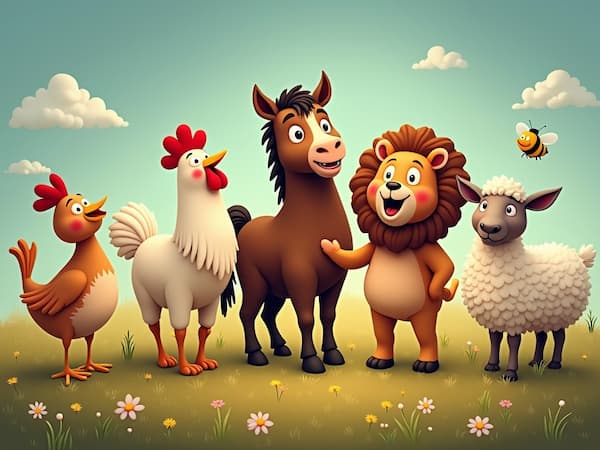Classical music composers have been inspired by every animal under the sun and in the sky!
From elephants to bees, here are fifteen animals that have inspired classical music:

Image created by FLUX-dev
Cat
Domenico Scarlatti: Keyboard Sonata in G Minor K30 “Cat Fugue” (1739)
Legend has it that keyboardist and composer Domenico Scarlatti had a beloved cat named Pulcinella.
Apparently, Pulcinella enjoyed walking on his keyboard. One day, she played an unusual theme that began the piece.
Scarlatti was inspired and expanded it into a full fugue. Within months of its publication, George Frederick Handel “borrowed” the theme to use in a concerto grosso.
Learn more about classical music inspired by cats.
Chicken
Joseph Haydn: Symphony No. 83 “The Hen” (1785)
Joseph Haydn wrote this symphony in 1785 for a six-symphony commission from a French nobleman.
The six symphonies were premiered in Paris by one of the best orchestras in Europe, led by Joseph Bologne, Chevalier de Saint-Georges, a biracial composer of African descent who was one of the most celebrated musicians of his age.
His Symphony No. 83 became famous for the jerky second theme of its first movement, which sounds like a hen clucking. You can hear it at 1:35 in the recording above.
Horse
Franz von Suppé: Overture to Light Cavalry (1866)
Operetta composer Franz von Suppé wrote the two-act Light Cavalry, which premiered in 1866.
Light Cavalry follows Vilma, an orphan who has been raised by her community and has grown into an attractive young woman.
She is in love with a man named Hermann. During a romantic moment between the two, dashing Hungarian Hussars arrive on horseback.
This operetta is rarely performed today, but the overture lives on as a concert piece, famous for its galloping horse-like rhythms portraying the Hussars.
Read more about horses in classical music.
Goat
Modest Mussorgsky: The He-Goat: A Worldly Story (1867)
“The Goat” creates a terrifying metaphor out of a goat.
The song tells the story of a maiden who is strolling in a meadow. She is terrified by a bearded, vicious goat: “downright a devil,” the narrator reports. She goes to hide.
The song then describes a maiden who goes to get married. Her husband is, like the goat, bearded and vicious…and “downright a devil.”
However, the narrator reports that the maiden does not hide from her husband. Instead, she embraces him and convinces him that she will be loyal.
It’s a story that leaves a bad taste in the mouth, but it certainly is one of the more memorable appearances of a goat in classical music.
Lion
Camille Saint-Saëns: Royal March of the Lions from The Carnival of the Animals (1886)
In 1886 Camille Saint-Saëns took a break from writing his third symphony to compose a suite of music just for fun. It was a musical portrait of various animals, and so he titled the work The Carnival of the Animals.
It was performed privately in 1886, but Saint-Saëns refused to publish it before his death, fearing that such a light-hearted work would ruin his reputation as a serious composer.
Saint-Saëns was right to fear the work’s potential popularity: it’s now his most famous piece and one of the most famous pieces of classical music ever written!
Butterfly
Edvard Grieg: “Butterfly” from Lyric Pieces, Book 3 (1886)
Over the course of his career, composer Edvard Grieg wrote sixty-six pieces for solo piano that are known as his Lyric Pieces.
He published them in ten collections, dating from between 1867 and 1901.
Grieg began his third book of Lyric Pieces with this work that imitates the flittering flutters of a butterfly’s wings.
Sheep
Richard Strauss: “The battle with the sheep” from Don Quixote (1897)
In 1897 Richard Strauss wrote a colorful tone poem based on the classic Spanish novel Don Quixote.
In that book, a delusional elderly man who has read too many books about chivalry loses touch with reality and decides that he himself is a knight.
In Don Quixote’s imagination, he goes to battle the vast army of what he believes is the great emperor Alifanfaron. In reality, the “army” is just a herd of sheep.
Strauss portrays the irritated bleating of the bewildered sheep herd as Don Quixote attacks them.
Bee
Nikolai Rimsky-Korsakov: Flight of the Bumblebee from The Tale of Tsar Saltan (1899-1900)
In the opera The Tale of Tsar Saltan, the Tsaritsa (the Tsar’s bride) gives birth to a male heir named Gvidon while the Tsar is at war.
Due to the meddling of Tsaritsa’s jealous sisters, the Tsar gets a message that the child is an inhuman monster.
The Tsaritsa and her son Gvidon are then exiled to a deserted island. While they’re there, Gvidon shows kindness to a magical swan. The swan offers to transform Gvidon into a bumblebee so he can fly across the ocean to meet his father.
Fish
Erik Satie: Le Poisson rêveur (1900-01)
Between 1900 and 1901, composer Erik Satie worked on an orchestral tone poem called Le Poisson rêveur, or “The Dreamy Fish.”
The entire process was a major struggle, and unfortunately, the piece was never finished. All we have today is a piano score with instrumentation suggestions scribbled in the margins.
The work was influenced by Debussy, who wrote Satie with a teasing question: “And this blasted dreamy fish? Did you make it take your hook?”
Hear more classical music about fish.
Cuckoo
Frederick Delius: On Hearing the First Cuckoo in Spring (1912)
In the pastoral tone poem On Hearing the First Cuckoo in Spring, composer Frederick Delius showcases an orchestrated version of the cuckoo’s delicate call.
The cuckoo call initially starts around 1:43 in the recording above. It returns again and again throughout the rest of the piece.
These nature sounds blend beautifully with the lush orchestral textures.
Lark
Ralph Vaughan Williams: The Lark Ascending (1914)
In 1914, right before the outbreak of World War I, Ralph Vaughan Williams wrote one of the great pieces of pastoral English music, a piece called The Lark Ascending.
Originally written for violin and piano and later orchestrated for violin and orchestra, it was inspired by the song of the lark, as well as a poem by George Meredith that describes the bird:
He rises and begins to round,
He drops the silver chain of sound
Of many links without a break,
In chirrup, whistle, slur and shake…
Tiger
Henry Cowell: Tiger from 2 Pieces (1925-28)
Cowell’s piano work Tiger, written between 1925 and 1928 and published in 1930, is based on a famous 1794 poem by William Blake entitled “The Tyger.”
In Blake’s “The Tyger”, the poem’s speaker asks a fierce tiger questions about its creation.
The poem emphasises imagery related to flames, between referring to the animal’s fiery eyes and how the tiger “burns bright.”
American composer Henry Cowell translates that fierceness into his piano adaptation by asking the player to play tone clusters with their elbows!
Dog
George Gershwin: Walking the Dog (1937)
In 1937, George Gershwin wrote the soundtrack to the Astaire-Rogers musical Shall We Dance.
In that movie, Fred Astaire plays an American ballet dancer who is pretending to be Russian, while Ginger Rogers plays a famous tap dancer.
This mix of dance genres was important to the score, and mixing jazz and classical influences was an entire specialty of Gershwin’s.
In Walking the Dog, Ginger Rogers is walking her dog back and forth on the deck of an ocean liner while Astaire, who is romantically interested in her, looks on. Finally, he bribes a ship’s officer to take the leash of a dog and begins to follow Rogers while she tries to avoid him.
Here’s the work as it appears in the film Shall We Dance:
Shall We Dance (1937) – Walking The Dog
Discover more classical music inspired by dogs.
Peacock
Zoltán Kodály: Variations on a Hungarian Folksong (“The Peacock”) (1938-39)
Composer Zoltán Kodály was passionate about incorporating Hungarian folk music into his compositions.
In the late 1930s, Kodály was commissioned by conductor Willem Mengelberg and the Concertgebouw Orchestra from Amsterdam.
For this important commission, Kodály decided to use a Hungarian folk song known as “The Peacock” as the basis for an orchestral work. This work ultimately turned into his Variations on a Hungarian Folksong (“The Peacock”).
The folk song’s lyrics include the line “The peacock flew upon the County Hall, poor prisoners to deliver”,: a reference to a mythical, metaphorical peacock that helped to rescue politically and culturally downtrodden Hungarians.
Whale
Alan Hovhaness: And God Created Great Whales (1970)
And God Created Great Whales was commissioned by the New York Philharmonic.
It was inspired by Genesis 1:21 from the Biblical creation story, which reads “And God created great whales, and every living thing that moveth.”
Actual recordings of whalesong are required for performances of this work. Hovhaness employs a massive orchestral sound to evoke the grandeur of these marine giants.
Conclusion
So, which of these fifteen animals is your favorite? Did we choose the best pieces for each one? Do you have a favourite piece portraying an animal? Let us know!
For more of the best in classical music, sign up for our E-Newsletter

